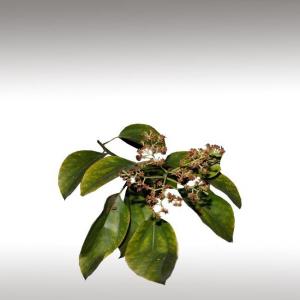
HO WOOD ESSENTIAL OIL (CINNAMOMUM CAMPHORA) - ESSENTIAL OILS

BASE / GENERAL DATA
Information submited: February 3, 2015 Modified: March 13, 2018 By: OperaDreamhouse
Botanical Name: Cinnamomum camphora
Common Method of Extraction: Steam Distillation
Part Typically Used: Leaves and twigs
Color: Transparent liquid
Consistency: Thin
Perfumery Note: Middle
Strength of Initial Aroma: Bright, warm, slightly woody
Cinnamomum Camphora is native to China south of the Yangtze River, Taiwan, southern Japan, Korea, and Vietnam, and has been introduced to many other countries. The first descriptions of the use of Cinnamomum Camphora dates back to the travels of Marco Polo.
Cinnamomum Camphora (commonly known as Camphor tree, Camphorwood or Camphor Laurel) is a large evergreen tree that grows up to 20 - 30 m tall. The leaves have a glossy, waxy appearance and smell of Camphor when crushed. Its pale bark is very rough and fissured vertically. Ho Wood is part of the Cinnamomum family, just like Ravintsara.
The wood has traditionally been used for the handles of Japanese swords and knives because it is soft and will not scratch the blades. It is very similar to Rosewood but produced from a much more renewable source.
Ho Wood essential oil is obtained by steam distillation of the bark, and also called Ho Leaf or Shiu Rosewood. The aroma is similar to Rosewood and can possibly be used as an alternative. Ho Woods high linalool content gives the tree bark floral notes, while the high concentration of cineole in the bark of Ravintsara exudes fresh notes.
Camphor is a white crystalline substance, obtained from the tree Cinnamomum Camphora. Primitive stills were set up in the mountainous areas in which the tree is usually found. The wood was chipped, these chips were steamed in a retort, allowing the Camphor to crystallize on the inside of a crystallization box, after the vapour had passed through a cooling chamber. Camphor was one of the most lucrative of several important government monopolies under the Japanese.
This oil yields up to 50% Camphor when rectified under vacuum. Leaf oils distilled form the leaves of Cinnamomum Camphora are generally colourless, although Indian oils may be pale yellow and pale green. Japanese and Taiwanese oils differ in the major constituent remaining after removal of Camphor.
Chemical structure:
Camphor Laurel contains volatile chemical compounds in all plant parts, and the wood and leaves are steam distilled for the essential oils. Camphor Laurel has six different chemical variants called chemotypes, which are camphor, linalool, 1,8-cineole, nerolidol, safrole, or borneol.
Cinnamomum Camphora contains 42 - 84% of the ketone Camphor with a recommended dermal maximum of 0.8%.
Common Method of Extraction: Steam Distillation
Part Typically Used: Leaves and twigs
Color: Transparent liquid
Consistency: Thin
Perfumery Note: Middle
Strength of Initial Aroma: Bright, warm, slightly woody
Cinnamomum Camphora is native to China south of the Yangtze River, Taiwan, southern Japan, Korea, and Vietnam, and has been introduced to many other countries. The first descriptions of the use of Cinnamomum Camphora dates back to the travels of Marco Polo.
Cinnamomum Camphora (commonly known as Camphor tree, Camphorwood or Camphor Laurel) is a large evergreen tree that grows up to 20 - 30 m tall. The leaves have a glossy, waxy appearance and smell of Camphor when crushed. Its pale bark is very rough and fissured vertically. Ho Wood is part of the Cinnamomum family, just like Ravintsara.
The wood has traditionally been used for the handles of Japanese swords and knives because it is soft and will not scratch the blades. It is very similar to Rosewood but produced from a much more renewable source.
Ho Wood essential oil is obtained by steam distillation of the bark, and also called Ho Leaf or Shiu Rosewood. The aroma is similar to Rosewood and can possibly be used as an alternative. Ho Woods high linalool content gives the tree bark floral notes, while the high concentration of cineole in the bark of Ravintsara exudes fresh notes.
Camphor is a white crystalline substance, obtained from the tree Cinnamomum Camphora. Primitive stills were set up in the mountainous areas in which the tree is usually found. The wood was chipped, these chips were steamed in a retort, allowing the Camphor to crystallize on the inside of a crystallization box, after the vapour had passed through a cooling chamber. Camphor was one of the most lucrative of several important government monopolies under the Japanese.
This oil yields up to 50% Camphor when rectified under vacuum. Leaf oils distilled form the leaves of Cinnamomum Camphora are generally colourless, although Indian oils may be pale yellow and pale green. Japanese and Taiwanese oils differ in the major constituent remaining after removal of Camphor.
Chemical structure:
Camphor Laurel contains volatile chemical compounds in all plant parts, and the wood and leaves are steam distilled for the essential oils. Camphor Laurel has six different chemical variants called chemotypes, which are camphor, linalool, 1,8-cineole, nerolidol, safrole, or borneol.
Cinnamomum Camphora contains 42 - 84% of the ketone Camphor with a recommended dermal maximum of 0.8%.

SPIRITUAL PRACTISES DATA

MEDICINE / HEALTH DATA

BEAUTY / COSMETICS DATA

FOOD / COOKING DATA
COMMENTS
No comments.


